The Sandy Bridge Review: Intel Core i7-2600K, i5-2500K and Core i3-2100 Tested
by Anand Lal Shimpi on January 3, 2011 12:01 AM ESTThe 6-series Platform
At launch Intel is offering two chipset families for Sandy Bridge: P-series and H-series, just like with Lynnfield. The high level differentiation is easy to understand: P-series doesn’t support processor graphics, H-series does.
There are other differences as well. The P67 chipset supports 2x8 CrossFire and SLI while H67 only supports a single x16 slot off of the SNB CPU (the chip has 16 PCIe 2.0 lanes that stem from it).
While H67 allows for memory and graphics overclocking, it doesn’t support any amount of processor overclocking. If you want to overclock your Sandy Bridge, you need a P67 motherboard.
6Gbps
Had SSDs not arrived when they did, I wouldn’t have cared about faster SATA speeds. That’s how it worked after all in the evolution of the hard drive. We’d get a faster ATA or SATA protocol, and nothing would really change. Sure we’d eventually get a drive that could take advantage of more bandwidth, but it was a sluggish evolution that just wasn’t exciting.
SSDs definitely changed all of that. Today there’s only a single 6Gbps consumer SSD on the market—Crucial’s RealSSD C300. By the middle of the year we’ll have at least two more high-end offerings, including SandForce’s SF-2000. All of these SSDs will be able to fully saturate a 3Gbps SATA interface in real world scenarios.
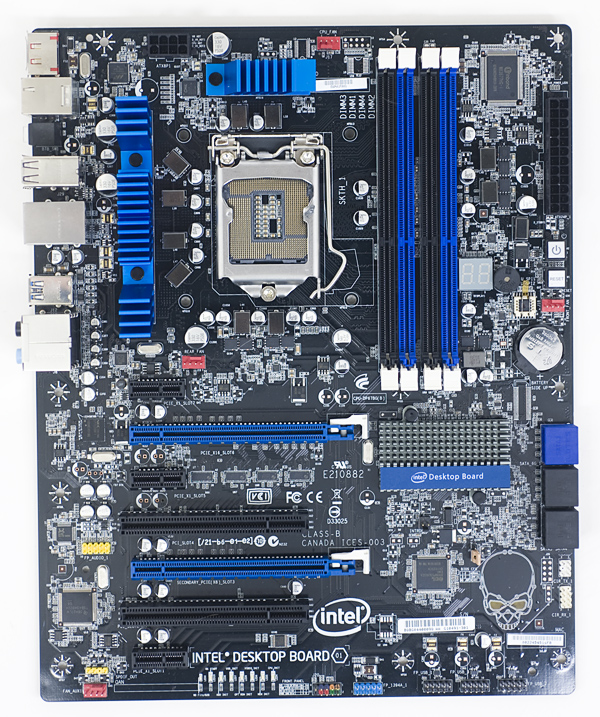
Intel's DP67BG—The blue SATA ports on the right are 6Gbps, the black ones are 3Gbps
To meet the soon to be growing need for 6Gbps SATA ports Intel outfits the 6-series PCH with two 6Gbps SATA ports in addition to its four 3Gbps SATA ports.
I dusted off my 128GB RealSSD C300 and ran it through a bunch of tests on five different platforms: Intel’s X58 (3Gbps), Intel’s P67 (3Gbps and 6Gbps), AMD’s 890GX (6Gbps) and Intel’s X58 with a Marvell 9128 6Gbps SATA controller. The Marvell 91xx controller is what you’ll find on most 5-series motherboards with 6Gbps SATA support.
I ran sequential read/write and random read/write tests, at a queue depth of 32 to really stress the limits of each chipset’s SATA protocol implementation. I ran the sequential tests for a minute straight and the random tests for three minutes. I tested a multitude of block sizes ranging from 512-bytes all the way up to 32KB. All transfers were 4KB aligned to simulate access in a modern OS. Each benchmark started at LBA 0 and was allowed to use the entire LBA space for accesses. The SSD was TRIMed between runs involving writes.
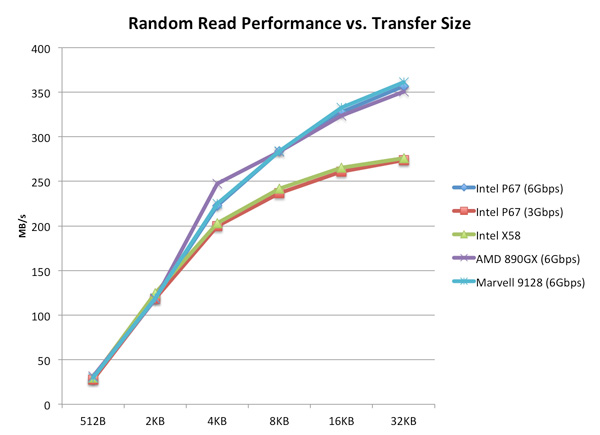
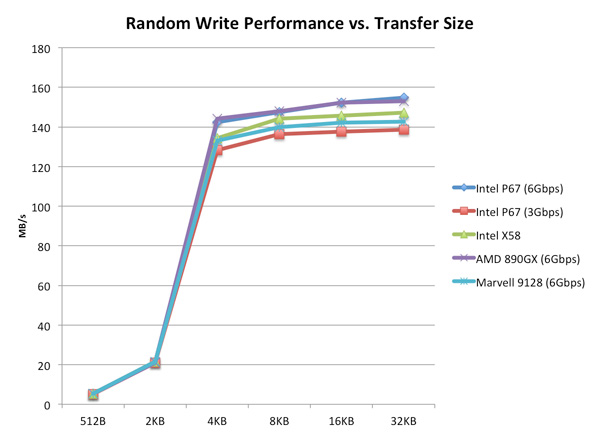
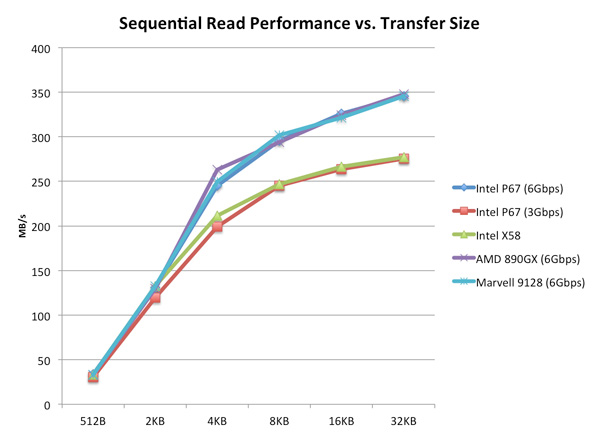
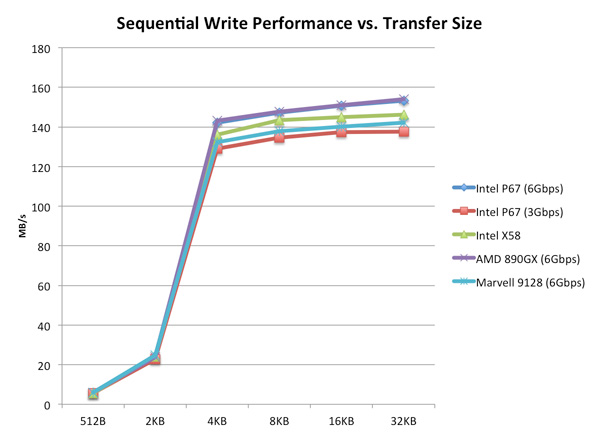
Among Intel chipsets I found that the X58 has stellar 3Gbps SATA performance, which is why I standardize on it for my SSD testbed. Even compared to the new 6-series platform there are slight advantages at high queue depths to the X58 vs. Intel’s latest chipsets.
Looking at 6Gbps performance though there’s no comparison, the X58 is dated in this respect. Thankfully all of the contenders do well in our 6Gbps tests. AMD’s 8-series platform is a bit faster at certain block sizes but for the most part it, Intel’s 6-series and Marvell’s 91xx controllers perform identically.
I hate to be a bore but when it comes to SATA controllers an uneventful experience is probably the best you can hope for.


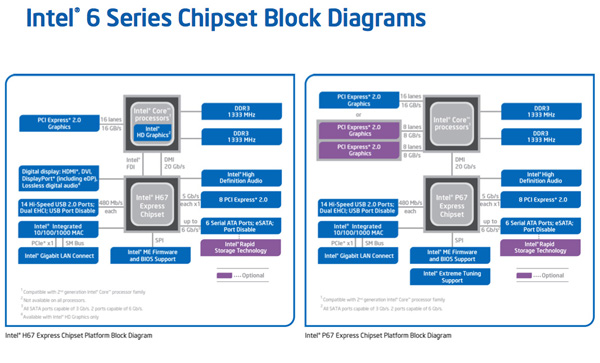








283 Comments
View All Comments
mosu - Monday, January 3, 2011 - link
If I want to spend every year a big lot of money on something I'll sell on eBay at half price a few months later and if I'd like crappy quality images on my monitor, then I would buy Sandy Bridge... but sorry, I'm no no brainer for Intel.nitrousoxide - Monday, January 3, 2011 - link
It really impressed me as I do a lot of video transcoding and it's extremely slow on my triple-core Phenom II X3 720, even though I overclocked it to 4GHz. But there is one question: the acceleration needs EU in the GPU, and GPU is disabled in P67 chipset. Does it mean that if I paired my SNB with a P67 motherboard, I won't be able to use the transcoding accelerator?nitrousoxide - Monday, January 3, 2011 - link
Not talking about SNB-E this time, I know it will be the performance king again. But I wonder if Bulldozer can at least gain some performance advantage to SNB because it makes no sense that 8 cores running at stunning 4.0GHz won't overrun 4 cores below 3.5GHz, no matter what architectural differences there are between these two chips. SNB is only the new-generation mid-range parts, it will be out-performed by High-End Bulldozers. AMD will hold the low-end, just as it does now; as long as the Bulldozer regain some part that Phenoms lost in mainstream and performance market, things will be much better for it. Enthusiast market is not AMD's cup of tea, just as what it does in GPUs: let nVidia get the performance king and strike from lower performance niches.strikeback03 - Tuesday, January 4, 2011 - link
I don't think we'll know until AMD releases Bulldozer and Intel counters (if they do). Seems the SNB chips can run significantly faster than they do right now, so if necessary Intel could release new models (or a firmware update) that allows turbo modes up past 4GHz.smashr - Monday, January 3, 2011 - link
This review and others around the web refer to the CPUs as 'launching today', but I do not see them on NewEgg or other e-tailer sites.When can we expect these babies at retail?
JumpingJack - Monday, January 3, 2011 - link
They are already selling in Malaysia, but if you don't live in Malasia then your are SOL :) ... I see rumors around that the NDA was suppose to expire on the 5th with retail availability on the 9th... I was thinking about making the leap, but think I will hold off for more info on BD and Sk2011 SB.slickr - Monday, January 3, 2011 - link
Intel has essentially shoot itself in the foot this time. Between the letters restrictions, the new chipset and crazy chipset differentiations between a P and a H its crazy.Not to mention they lack USB 3.0, ability to have an overclock mobo with integrated graphics and the stupid turbo boost restrictions.
I'll go even more and say that the I3 core is pure crap and while its better than the old core I3 they are essentially leaving the biggest market the one up the $200 dollars wide open to AMD.
Those who purchase CPU's at $200 and higher have luck in the 2500 and 2600 variants, but for the majority of us who purchase cpu's bellow $200 its crap.
Essentially if you want gaming performance you buy I3 2100, but if you want overall better performance go for a phenom II.
Hopefully AMD comes up with some great CPU's bellow the $200 range that are going to be with 4 cores, unlimited turbo boost and not locked.
Arakageeta - Tuesday, January 4, 2011 - link
It seems that these benchmarks test the CPUs (cores) and GPU parts of SandyBridge separately. I'd like to know more about the effects of the CPU and GPU (usually data intensive) sharing the L3 cache.One advantage a system with a discrete GPU is that the GPU and CPUs can happily work simultaneously without largely affecting one another. This is no longer the case with SandyBridge.
A test I would like to see is a graphics intensive application running while another another application performs some multi-threaded ATLAS-tuned LAPACK computations. Do either the GPU or CPUs swamp the L3 cache? Are there any instances of starvation? What happens to the performance of each application? What happens to frame rates? What happens to execution times?
morpheusmc - Tuesday, January 4, 2011 - link
To me it seems that marketing is defining the processors now in Intel rather than engineering. This is always the case but I think now it is more evident than ever.Essentially if you want he features that the new architecture brings, you have to sell out for the higher end models.
My ideal processor would be a i5-2520M for the desktop: Reasonable clocks, good turbo speeds (could be higher for the desktop since the TDP is not that limited), HT, good graphics etc. The combination of 2 cores and HT provides a good balance between power consumption and perfromance for most users.
Its desktop equivalent price-wise is the 2500, wich has no HT and a much higher TDP because of the four cores. Alternatively, maybe the 2500S, 2400S or 2390T could be considered if they are too overpriced.
Intel has introduced too much differentiation in this generation, and in an Apple-like fashion, i.e. they force you to pay more for stuff you don't need, just for an extra feature (eg. VT support, good graphics etc) that practically costs nothing since the silicon is already there. Bottomline, if you want to have the full functionality of the silicon that you get, you have to pay for the higher end models.
Moreover, having features for specific functions (AES, transcoding etc) and good graphics makes more sense in lower-end models where CPU power is limited.
This is becoming like the software market, where you have to pay extra for licenses for specific functionalities.
I wouldn't be surprised if Intel starts selling "upgrade licenses" sometime in the future that will simply unlock features.
I strongly prefer AMD's approach where all the fatures are available to all models.
I am also a bit annoyed that there is very little discusison about this problem in the review. I agree that technologically Sandy Bridge is impressive, but the artificial limiting of functionality is anti-technological.
ac2 - Tuesday, January 4, 2011 - link
Agreed, but, apart from the K-series/ higher IGP/ motherboard mess up (which I think should be shortly cleared up), all the rest of it is just smart product marketing...It irritates readers of AnandTech, but for the most people who buy off-the-shelf it's all good, with integrators patching up any shortcomings in the core/ chipset.
The focus does seem to be mobile, low-power and video transcode, almost a recipe for macbook!!